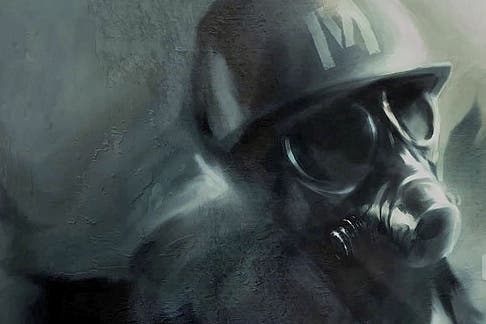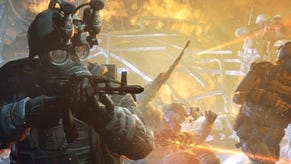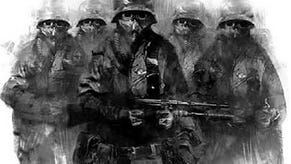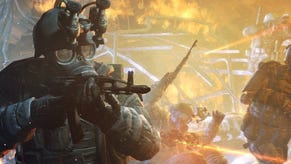Metro: Last Light preview: The Underground Man
4A's latest promises improvements in terms of the weaponry, the stealth, and the surroundings.
Nixies are a wonderful piece of retro tech: they're a means of creating digital displays that relies on funny little glass vacuum tubes. Fragile and captivating, it's hard to look at this ingenious relic of the 20th century without wishing they'd caught on - even though they'd presumably have meant that we'd all be making weekly trips to the local horologist. Eccentrics like Steve Wozniak have Nixie tube wristwatches, at any rate - and in Metro: Last Light, so will you, the gadget's bright, rather spindly meshed lettering linked to the internal clock on your PC or console. Whatever happens, there's that digital readout, staring up at you from the wrist of Artyom, the series' sharp-shootin' protagonist, as he ventures through this strange, frightening jury-rigged world where yesterday and tomorrow have collided painfully.
The Nixie model replaces Artyom's old wristwatch: the more traditional dial-and-hands-based number that Metro 2033 veterans relied on to count down the time until they were in need of a new air filter as they explored Moscow's irradiated topside, or to clue them in to how well hidden they were during stealth sections. The new watch does all of that too, of course, and when it comes to stealth, it's a lot simpler and - hopefully - less frustrating with it. In Last Light, a blue lamp on the watch's face tells you whether you're visible or not. It's binary. Tidy stuff.
That watch will be your consistent companion through 4A Games' sequel, and it's a fixed point at which two of the series' key themes come together, too. One is stealth, and it was front and centre during a recent developer playthrough of the fiercely pretty PC version over at THQ's UK HQ. The other lies with the Nixies and that loveably nuts-and-bolts approach to knackered old gear they represent. Metro's world is a dangerous scrapheap where everything useful has been cobbled together from mis-matched parts: a place in which years of living in the subways of Moscow after a nuclear attack have lead technology in strange trajectory.
And this trajectory's most visible in the game's glorious load-out of weapons, many of which return from the original adventure, after being gifted with lovingly crafted new animations and funny little design tweaks. The bastard SMG is back, of course: the go-to blaster with its bizarre side-loading ammo clip, giving players the odd impression that it's perpetually signalling for a polite left-hand turn. It's a joy to watch the bastard juddering around, spraying lead as bullets steadily work their way through the chamber, and the magazine clip rattles along like the carriage on an old typewriter.
Even better is the Tihar, a pneumatic ball-bearing sniper rifle - well, that's if you give it a scope, anyway - that chunters like a deadly stapler, each shot muffled, yet resoundingly precise. The Tihar comes with a glow-in-the-dark pressure gauge on the side, and the needle's constantly shivering up and down. Reload it and you can watch the springs that run along the barrel twitch and flex. You'll have to nanny it somewhat, too, cranking the pressure up manually to maintain projectile velocity, rendering it a devastating but rather needy beast.
Pistols, shotguns, all manner of variants: on top of the game's standard templates, gun customisation has been comprehensively opened out with the option to tailor the weapons you find until they're truly gruesome and obscure. They're mutant tools for a mutant world. You're now free to fill your three weapon slots with any kind of load-out you please, and at shops, so long as you have enough bullets to trade (once again, they act as currency, but the interface has been completely overhauled with clarity in mind) you can create some real Frankenstein's monsters. Swap out grips and whack on new optics, put a huge stock and an extended barrel on a pistol to improve accuracy, or throw a silencer, larger clip, and a sniper scope on, y'know, an AK47: there are some deadly nut-case contraptions lurking in wait for you. It means that you're faced with an arsenal whose patched-together wonkiness is a regular reminder of the thrift and ingenuity that marks out the survivors in this horrible place, while the ammo rationing that comes with survival horror ensures that each trip to the upgrade menu will provide you with some truly challenging decisions.
Environments show signs of the same piecemeal resourcefulness. As with the weapons, the landscapes of Last Light expand on the first game's ideas, but with greater clarity and invention. Shoot-outs are staged in cultivation chambers where plants lurk in weather-beaten bath tubs, and the staircases leading to gantries are likely to be bizarre contraptions made of the slatted and grooved panels from an old metro escalator. Home-made water wheels turn turbines, while the city states of each subway station are filled with distractions: a train-car/brothel where there are targets waiting to be eliminated, pressed-tin sheds holding games of chance, or a tumbledown bar where each drink Artyom sucks back sees the old hag next to him growing younger and younger in his eyes. One station's called Venice: it's half-flooded, of course, with pools of luminous green water. That's turned it into a grimy sort of grotto where men fish for mutated sea beasts and rats smoke on the slow-turning spindles of a rotisserie grill. Rats are a bit of a theme after the apocalypse, it would seem: explore Venice's outer fringes and you can head down to the ol' rat-shooting range for some downtime.
"Gun customisation has been comprehensively opened out with the option to tailor the weapons you find until they're truly gruesome and obscure. They're mutant tools for a mutant world."
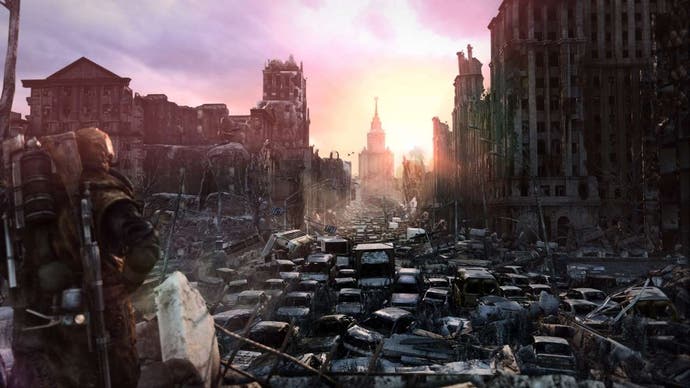
As ever, these hubs provide a welcome break from the tension of working your way through Moscow's tunnels and topside mires. When it comes to the action, stealth is heavily encouraged, but the AI seems a little more playful this time around. It's perception-based, according to the developers, and its approach to sight and sound doesn't seem to suggest the super-human awareness apparent in the first Metro game, which could punish even the smallest errors with a room full of tooled-up maniacs who somehow knew exactly where you were lurking. On top of that, the maps have been opened out a bit to encourage freedom of approach: expect split-level sections where you're given a choice of routes through Reich territory, for example, and as you explore, you'll find enemies going about their business in convincing ways, chatting and whistling to themselves rather than waiting, guns drawn, for you to stumble in.
If you're not feeling very imaginative, Last Light's riddled with fuse boxes for you to meddle with in order to create little ambushes for whoever comes to fix the overheads, and if you're careless, the game copes surprisingly well with all-out firefights, whether you're indoors or outdoors, picking a path over the scarred earth and enraging its gigantic beasts. Crabs, bat-things, a muddle of human factions who'd all quite like to put a ball-bearing through your neck: things can go awry fairly quickly here, and the game creates a powerful sense of involvement, regardless of what you're up to.
Racing around under the open sky with your mask fogging up, your chesty wheezing over soundtrack and that watch ticking down seconds until you need to change a filter? Or maybe you're deep underground, extinguishing each light source you come from and treating every kink in the map as a potential set-piece? Wherever you are, the minimal HUD allows the game-world to truly envelop you.
Get set for another horribly beautiful adventure, in other words: a journey that's linear, but filled with punchy moment-to-moment choices, and grimly told, yet littered with tricksy humour and wonderful sights. Come, friendly bombs: I've got a pneumatic sniper-rifle and a six-chambered shotgun, and I'm pretty much ready for you.
